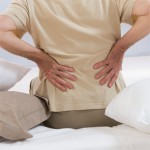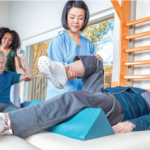

Back pain is a common occurrence, so much so that most adults will have at least one episode of back pain at some point in their lives. Fortunately, most of these episodes last only a few days and resolve if patients maintain normal activity levels, avoid the detrimental effects of too much bed rest, use over-the-counter pain relievers with caution, and seek the attention of a health professional if the pain or other symptoms persist or worsen over time.
The signs and symptoms of back pain are highly varied, and the cause of back pain may not be known. A systemic illness such as ankylosing spondylitis or other condition such as a vertebral fracture, spinal stenosis, herniated disk, or spinal tumor may be the cause in some cases. In these instances, a team including a physician will be needed to address the patient’s pain. However, most back pain is not due to a disease or a health condition, but is “mechanical” in nature, most likely related to some combination of muscle strain, faulty alignment of the vertebrae, abnormal flexibility of the spinal column—either too much or too little—and impingement of nerves and blood vessels that exit the spine. Physical therapists (PTs) have specific expertise in the diagnosis and treatment of “mechanical” spinal neck and back pain.
PTs are licensed health professionals who are academically educated in doctoral programs and clinically trained to focus on improving function, alleviating pain, and preventing disability. Some PTs have additional training and board certification as orthopedic PT specialists.
PTs should be directly accessed as a first line of defense in the treatment of back pain lasting more than a few days.
All PTs will develop and implement a treatment plan individualized to each person’s particular problems after a comprehensive, detailed examination. This examination will include the use of standardized instruments, such as the Oswestry Low Back Pain Disability Questionnaire, the Roland-Morris Back Pain Questionnaire, and the Neck Disability Index, as well as other reliable and valid tests and measures that specifically evaluate the muscles, bones and joints, and nerves of the spinal column from the neck to the pelvis, including the assessment of strength and flexibility of the trunk and extremities.1-3 Assessment of posture and body mechanics is particularly important in determining the factors that have contributed to back pain.
A PT’s examination will also evaluate balance and coordination and how well the patient’s cardiovascular and pulmonary systems tolerate various levels of activity. Additionally, a thorough understanding of psychosocial influences upon pain is imperative in conditions such as fibromyalgia. These measurements will inform the PT’s understanding of how changes in the patient’s daily self-care needs, physical activity, and work or school performance has been affected by their spinal pain, in addition to which activities and positions exacerbate or decrease their pain.
After assessing the examination results, the PT has an array of interventions to use in treating spinal pain. The mainstay of a PT treatment for back pain includes therapeutic exercise to increase muscle and joint strength and flexibility, mobilization and manipulation of the spine, postural education and instruction in proper body mechanics and gait, and conditioning to improve stamina for functional activities and tolerance for physical activity. When appropriate, the PT will recommend or fabricate various supports for the spine and offer assistive devices that decreased the stress on the muscles and joints during functional activities. Sometimes a PT will do an ergonomic analysis of the workplace, particularly to ensure that work tasks, physical facilities, and computer workstations support good postural habits and body mechanics.
Maintaining a healthy lifestyle of diet and physical activity is critical to prevent spinal, neck and back pain or avoid a recurrence. Many people who are at risk for back pain simply are afraid to exercise for fear they will injure themselves. Individuals who have not maintained age- and sex-appropriate weight may find that exercise and physical activity is just “too hard.” PTs will also be able to advise a person on how to get started with a safe and pain-free exercise program that will not aggravate neuromusculoskeletal problems and progress that program as tolerance for physical activity increases.
PTs should be directly accessed as a first line of defense in the treatment of back pain lasting more than a few days to ensure that an acute episode does not turn into a recurrent, debilitating condition. As health professionals long recognized by the medical community, PTs will communicate directly with primary care physicians and specialists such as rheumatologists to ensure positive outcomes.
Dr. Guccione is professor and chair, Department of Rehabilitation Science, College of Health and Human Services, George Mason University in Fairfax, Va. Dr. Richardson is professor emeritus, School of Medicine, Duke University Medical Center and chief clinical officer, Universal SmartComp in Washington, Pa.
References
- Fairbank JC, Couper J, Davies JB, O’Brien JP. The Oswestry low back pain disability questionnaire. Physiotherapy. 1980; 66:271-273.
- Roland M, Morris R. A study of the natural history of back pain, part I: Development of a reliable and sensitive measure of disability in low-back pain. Spine. 1983;8:141-144.
- Vernon H, Mior S. The Neck Disability Index: A study of reliability and validity. J Manipulative Physiol Ther. 1991;14:409-415.


